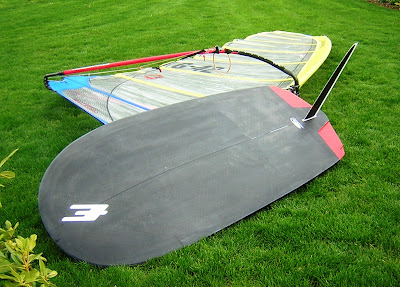Sailrocket is an ambitions project to make an experimental sailboat (I cringe at the term, given that this craft bears about as much resemblance to what I generally think of as a sailboat as a Lamborghini does to a Yugo) go world record speeds. For a long time, there's been an interesting dual development on the speed circuit.
On the one hand, you've had attempts like Yellow Pages and MI and (significantly larger and more open-ocean oriented) Hydroptere using pretty sophisticated technology and rather intricate and complex designs to balance the physics in an efficiency game - meaning they have tried to push the boundaries of lift/drag ratios on all foils and played with ways to leverage their righting moment to produce high speeds in reasonably low wind speeds (Sailrocket just produced 52 knot peak speeds in roughly 25 knots of breeze).
On the other hand, you've had the windsurfers and, recently (and with spectacular success) kiters, play a completely different game of simplicity and brute force. Yes, the wipeouts for them have been spectacular, too, but they don't involve a 20 foot craft looping - just a good old fashioned endo or teabagging at very high speeds (and no doubt a lot of pain). Kiters have learned to harness an advantage of their platform, which is that kites generate vertical lift - that allows them to use boards so tiny, they make windsurfers' speed boards (at 45 cm or less width) look monstrous. Pair that with their tiny fins, and they could not only reduce drag, but they could also find smoother water w/o fear of things getting too shallow. Pair that with the geometry of the whole setup giving them more favorable leverage, and it's hard to see windsurfers catching up.
So far, the simple brute force approach has the edge, with Yellow Pages in 93 the only efficiency play in the long list of first windsurfers, then again windsurfers (Maynard and Albeau, really, as they were in a class by themselves), and now kiters that have held the outright record.
What's becoming obvious, though, is that there's a middle ground. The kites are taking a page from the "boats" in that they optimize low drag by employing vertical lift to reduce wetted surface (only, they do it by simply having their kites drag them up while accelerating, as opposed to using hydrofoils to get a hull out of the water). They're also employing leverage for their righting moment - only they do it by decoupling the airfoil from the sailor/craft package via long kite strings as opposed to utilizing outriggers. So they're doing the same things, but radically more simply (and thus, one might argue, more elegantly). Which allows them faster and cheaper development cycles (tuning kites is a matter of a simple recut and some tweaks to line geometry; shaping a new kite board or producing a new fin takes a matter of days and investment in the hundreds of dollars, not tens or hundreds of thousands).
The kiters have thus managed to push the solution space boundaries by one-upping windsufers on simplicity while at the same time gaining on the efficiency front (note that they're making record runs in lower wind speeds - which means they've got a feedback loop going that gives them more chances at records). To get another crack at the outright record, windsurfing will have to figure out how to play the efficiency game - but still retain its simplicity (or else it will be cost-prohibitive and run into the issue of slow development cycles that seems to be keeping the boats from keeping up with the kites). That means truly exotic hydrofoils and outriggers and such are probably out. Perhaps launching from a moving boat (to allow for smaller boards) might work (hey, it's what they do with speed record aircraft so they don't have to have big draggy wings); that seems to make the need for super high and consistent winds only worse, however, and will further cut down on eligible venues. Aircraft carrier-style catapults probably add a bit too much complexity (but might produce some spectacular YouTube moments...).
Fun stuff!


















